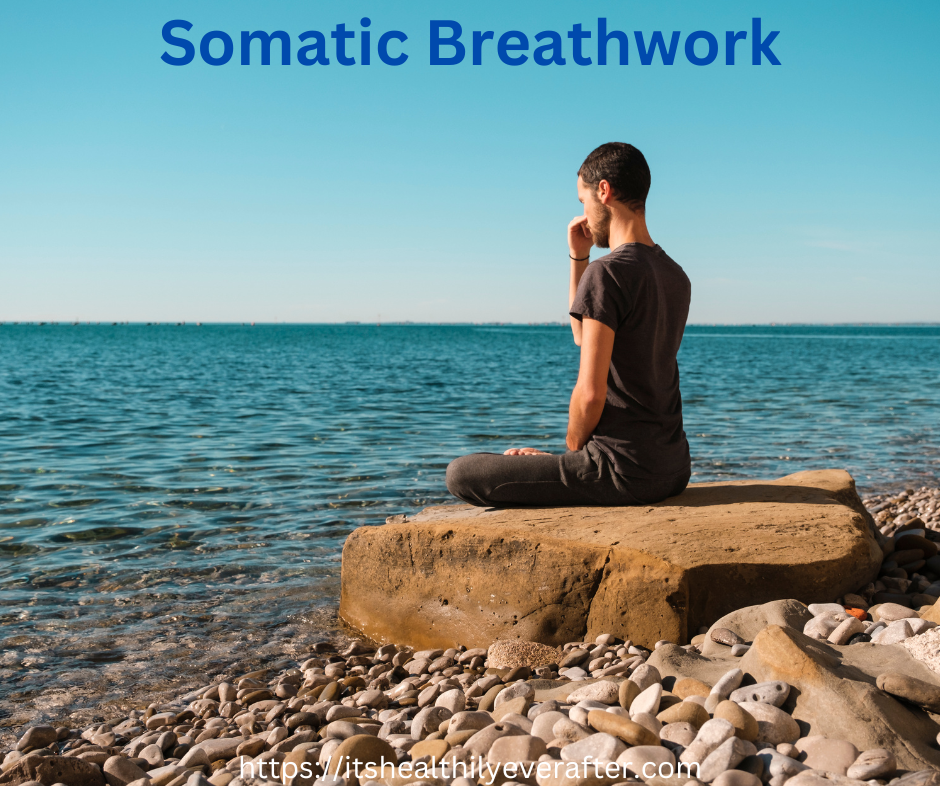Somatic breathwork is an incredibly powerful form of self-healing. It is a therapeutic practice that uses conscious, connected breath to move energy and release trauma that is stored in the body. By connecting to our breath, we can open up a connection to our physical, mental, and emotional bodies, allowing us to tap into and heal from past traumas. In this blog post, we’ll explore what somatic breathwork is, how it works, and how it can help you to release trauma that is stored in the body.
Table of Contents
What is Somatic Breathwork?
Somatic Breathwork is a holistic approach to healing that focuses on the connection between the body, mind, and breath. It is a technique that uses breath to release physical and emotional tension that may be stored in the body. Somatic Breathwork is based on the idea that the breath is a powerful tool that can be used to unlock blocked energy in the body and help us heal from emotional and physical trauma.
The word ‘somatic’ means ‘of the body’ and the practice of Somatic Breathwork emphasizes the importance of bodily sensations and experiences. It involves becoming aware of how the breath affects the body and using this awareness to create deep healing experiences.
Somatic Breathwork can be done individually or in a group setting with the guidance of a trained facilitator. The technique involves various breathing patterns that aim to promote relaxation and balance in the body. It can be practiced lying down or sitting and is typically done for about 30 minutes.
The practice of Somatic Breathwork can be an effective way to heal emotional trauma. It provides a safe space for individuals to release emotions that may be stuck in the body and create a sense of inner peace and clarity. By releasing physical tension, Somatic Breathwork can help individuals connect with their emotions and increase their awareness of their body and its needs.
Overall, Somatic Breathwork is a powerful healing technique that can be beneficial for anyone seeking a deeper connection with their body and emotional well-being. It is a tool that can be used to promote relaxation, reduce stress, and help individuals tap into their inner wisdom and strength.

The Science Behind Somatic Breathwork
Somatic breathwork has gained popularity in recent years as an effective form of healing. But what is the science behind it?
Breathwork involves intentionally manipulating the breath to create certain physiological responses in the body. Through specific breathing techniques, somatic breathwork aims to regulate the nervous system and bring the body back into a state of balance.
Research has shown that breathwork can help reduce symptoms of anxiety, depression, and PTSD by regulating the autonomic nervous system, which controls our body’s response to stress. Additionally, breathwork can help improve heart rate variability, a marker of overall health and resilience.
Somatic breathwork specifically targets the somatic, or bodily, experience of trauma. Trauma is often stored in the body as physical sensations and traditional talk therapy may not be enough to fully process and release it. Somatic breathwork aims to help individuals connect with these sensations and release them through conscious breathing.
Studies have shown that somatic breathwork can help reduce symptoms of trauma and PTSD, including intrusive thoughts, hypervigilance, and emotional numbing. It may also improve overall well-being and quality of life.
While the exact mechanisms behind somatic breathwork are still being studied, it is clear that conscious breathing can have a profound impact on both the body and mind. Through regulating the nervous system and connecting with the physical sensations of trauma, somatic breathwork can be a powerful tool for healing.

How Somatic Breathwork Can Help Release Trauma
Somatic Breathwork is a highly effective tool for releasing trauma that has been stored in the body. This trauma can often be the root cause of chronic physical, mental and emotional pain. Trauma can arise from a range of experiences such as accidents, physical or emotional abuse, loss of a loved one, illness, or even stress at work. Trauma can manifest as physical symptoms like muscle tension, headaches, digestive issues, and chronic pain, and emotional symptoms like anxiety, depression, fear, and anger.
Somatic Breathwork can help heal the body by working on the nervous system. The autonomic nervous system has two branches- the sympathetic nervous system (SNS) and the parasympathetic nervous system (PNS). The SNS is responsible for the body’s ‘fight or flight’ response to danger, while the PNS helps the body to relax and recover. Trauma can keep the SNS constantly activated, leading to chronic physical, emotional, and psychological symptoms.
By practicing Somatic Breathwork, individuals can shift their focus from the outside world to the internal sensations of their body. This process can help to deactivate the SNS and activate the PNS. This shift allows the body to move from a state of tension and stress to one of relaxation and healing.
The practice of Somatic Breathwork also helps individuals to process their trauma by facilitating the release of blocked emotions that have been trapped in the body. Breathing deeply and rhythmically helps to increase oxygen and blood flow throughout the body, and this can help to move stagnant energy and emotions that are stuck in the body.
Somatic Breathwork is a safe and effective practice that can help to release stored trauma and promote healing of the body and mind. It is a gentle and non-invasive therapy that can be practiced by anyone, regardless of age or fitness level. Through this practice, individuals can find a deeper connection to their body and emotions, and start to feel a sense of release from past experiences.
How to practice Somatic Breathwork
If you’re interested in trying somatic breathwork to aid in your healing journey, there are a few simple steps to follow. First, find a comfortable and quiet space where you won’t be disturbed. This could be your bedroom, living room, or any other space where you feel relaxed and at ease.
Next, get into a comfortable position. This could be sitting cross-legged on the floor, lying down on a yoga mat or bed, or any other position that feels comfortable to you.
Now, focus on your breath. Take a deep breath in through your nose, filling your lungs completely with air. Hold your breath for a few seconds, and then slowly release it through your mouth. Repeat this for a few minutes until you start to feel more relaxed and centered.
As you continue to breathe deeply, pay attention to any physical sensations you may be experiencing. You may notice tension or tightness in certain areas of your body. Simply breathe into those areas, allowing the breath to release any tension or stress.
You may also want to incorporate some gentle movement into your practice. This could include stretching, yoga poses, or even dance. The goal is to connect your breath with your body, allowing you to release any stuck energy or emotions.
Remember that somatic breathwork is a powerful tool for healing, but it’s important to approach it with a sense of curiosity and openness. Be gentle with yourself and don’t push yourself too hard. With time and practice, you’ll begin to feel the transformative power of this practice.
Is Somatic Breathwork safe?
As with any form of healing practice, it is important to consider the safety of Somatic Breathwork. While this practice can offer significant benefits for individuals seeking to release trauma and stress from the body, it is important to understand that everyone’s experience with the practice will be different. Some individuals may find the deep breathing exercises to be intense or uncomfortable, while others may feel a deep sense of release and relaxation.
It is recommended that individuals who are interested in trying Somatic Breathwork first consult with a trained practitioner to learn about the practice and ensure that it is safe for their unique needs. It is also important to practice Somatic Breathwork in a safe and controlled environment, free from distractions and with proper supervision.
Overall, while there is always a potential risk involved with any form of healing practice, many individuals have found significant benefits and relief from practicing Somatic Breathwork. By approaching this practice with an open mind and a willingness to listen to the body’s cues, individuals can safely and effectively release trauma and tension from the body, promoting a greater sense of overall health and well-being.
Which breathing style is the strongest?
When it comes to somatic breathwork, there is no one-size-fits-all answer to this question. Every person’s body and breath patterns are unique, and what works for one individual may not work for another.
However, it’s important to note that the strength of a breathing style is not necessarily what matters most. What’s more important is the intention behind the breathwork practice, and how it is used to support healing and release trauma stored in the body.
That being said, many people find that deep, diaphragmatic breathing is a powerful tool for releasing tension and trauma in the body. By breathing deeply into the belly and allowing the diaphragm to expand, we can increase our body’s oxygen levels, which can help reduce stress and anxiety.
Additionally, some people find that alternate nostril breathing (also known as Nadi Shodhana) is a strong breathing style for promoting relaxation and balance in the body. This practice involves breathing in through one nostril and out through the other and can help calm the mind and soothe the nervous system.
Ultimately, the strength of a breathing style depends on how it is used within a somatic breathwork practice. By working with a skilled practitioner or engaging in self-guided breathwork exercises, individuals can explore different breathing styles and find what works best for their unique bodies and needs. Breathing of the sun is considered a powerful breathwork technique for generating heat and energy in the body, while box breathing (also known as square breathing) can help promote a sense of calm and relaxation. Regardless of the specific breathing style used, somatic breathwork is a holistic approach to healing that involves connecting with the body and breath in a profound way.
The breath can be used as a tool to release tension and trauma stored in the body, helping individuals to feel more grounded, centered, and empowered. By engaging in regular somatic breathwork healing practices, individuals can cultivate a deeper understanding of their bodies and emotions, and learn how to work with their breath to support physical, mental, and emotional well-being.

Case study
Somatic breathwork has become increasingly popular in recent years for its ability to help release trauma stored in the body. This therapeutic practice is not only backed by science but has also been credited with many successful stories of healing, including my own.
For years, Ria Margaret struggled with chronic pain and emotional turmoil that seemed to be rooted in past trauma. She tried a variety of different therapies and techniques, but nothing seemed to alleviate her pain for good. That’s when she discovered somatic breathwork.
At first, she was hesitant to try it out as it sounded like yet another gimmicky wellness trend. But after doing some research, she realized that somatic breathwork is grounded in a deep understanding of how the body holds onto trauma and how to release it. And so, she decided to give it a try.
During her first session, she remember feeling a bit overwhelmed by the process. But as she continued to breathe deeply, she felt a sense of release that she had never experienced before. She was able to access and release stored emotions and physical tension that she had been carrying for years.
Over time, somatic breathwork practice helped her to heal in ways that she never thought possible. The chronic pain that she had been living with for years began to dissipate, and her emotional state improved dramatically. It was as though the trauma that had been weighing her down for so long had finally been released.
FAQs – Somatic Breathwork
1. What is Somatic Breathwork?
- Somatic Breathwork is a therapeutic practice that utilizes conscious breathing techniques to promote self-awareness, emotional healing, and personal growth. It involves using the breath as a tool to access and release tension, trauma, and emotional blockages stored in the body.
2. How does Somatic Breathwork differ from other forms of breathwork?
- Somatic Breathwork focuses on integrating breath awareness with mindful movement, body awareness, and emotional expression to facilitate holistic healing and transformation. Unlike some traditional breathwork practices that solely emphasize controlled breathing patterns, Somatic Breathwork incorporates a deeper exploration of somatic sensations and emotional experiences.
3. What are the benefits of practicing Somatic Breathwork?
- Practicing Somatic Breathwork can offer a wide range of benefits, including stress reduction, relaxation, increased emotional resilience, enhanced self-awareness, improved mental clarity, and release of physical and emotional tension. It can also support trauma healing, promote emotional regulation, and deepen the mind-body connection.
4. How does Somatic Breathwork affect the nervous system?
- Somatic Breathwork can influence the autonomic nervous system, shifting the body from a state of stress and activation (sympathetic dominance) to a state of relaxation and restoration (parasympathetic activation). By engaging in slow, deep breathing patterns and mindful awareness, individuals can elicit the body’s relaxation response, promoting a sense of calm and well-being.
5. Who can benefit from practicing Somatic Breathwork?
- Somatic Breathwork can benefit individuals of all ages and backgrounds, including those seeking stress relief, emotional healing, personal growth, and self-discovery. It can be particularly beneficial for individuals dealing with trauma, anxiety, depression, chronic pain, or other emotional or somatic challenges.
6. Is Somatic Breathwork suitable for beginners?
- Yes, Somatic Breathwork is accessible to beginners and does not require any prior experience with breathwork or meditation. Practitioners can start with simple breathing exercises and gradually explore more advanced techniques as they become comfortable with the practice. Guidance from a trained facilitator or therapist can also provide support and guidance for beginners.
7. Are there any contraindications or precautions for practicing Somatic Breathwork?
- While Somatic Breathwork is generally safe for most individuals, it may not be suitable for everyone, especially those with certain medical conditions such as cardiovascular disorders, respiratory conditions, or acute mental health issues. It’s essential to consult with a healthcare professional before starting any new breathwork practice, especially if you have pre-existing health concerns.
8. How often should I practice Somatic Breathwork?
- The frequency of Somatic Breathwork practice can vary depending on individual needs, preferences, and schedules. Some people may benefit from daily practice, while others may find weekly or bi-weekly sessions more suitable. Consistency and regularity are key to experiencing the full benefits of Somatic Breathwork.
9. Can Somatic Breathwork be practiced alone or is it better in a group setting?
- Somatic Breathwork can be practiced both individually and in a group setting, and each approach offers unique benefits. Solo practice allows for self-guided exploration and introspection, while group sessions provide opportunities for shared experiences, support, and collective healing energy. Both options can be valuable, and individuals can choose the format that resonates most with them.
10. How can I learn more about Somatic Breathwork and find a qualified practitioner or facilitator?
- To learn more about Somatic Breathwork and find a qualified practitioner or facilitator, consider researching local workshops, retreats, or training programs specializing in somatic therapy, breathwork, or mindfulness. Online resources, books, and reputable organizations dedicated to breathwork and somatic healing can also provide valuable information and guidance.




